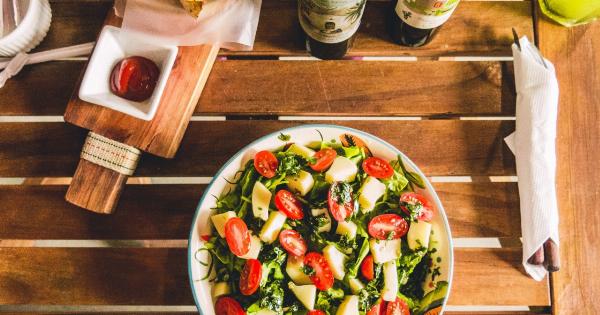When it comes to convenience and speed, the microwave is a kitchen appliance that many of us rely on. It can warm up leftovers, defrost frozen foods, and even cook certain dishes. However, not all foods are suitable for microwaving.
In fact, there are some foods that should never be nuked in the microwave due to various reasons such as texture, flavor, or even safety concerns. Here are 30 foods that you should never nuke in the microwave:.
Foods to Avoid Microwaving
1. Eggs
Microwaving eggs can result in a messy explosion. The steam that builds up inside the egg can cause it to burst, creating a big mess.
2. Grapes
Grapes contain a significant amount of water, and when exposed to microwave radiation, they can heat up quickly and potentially explode.
3. Frozen Meat
While it may be tempting to defrost frozen meat in the microwave, doing so can lead to uneven defrosting, which may promote the growth of harmful bacteria.
4. Hot Peppers
Microwaving hot peppers can release their natural oils, causing them to become extremely spicy. It can also irritate the eyes and respiratory system.
5. Breast Milk
Heating breast milk in a microwave can result in hot spots that can burn a baby’s mouth. It’s best to warm breast milk using gentle heat, such as warm water.
6. Chicken
When chicken is microwaved, it can become rubbery and lose its flavor and juicy texture. It’s better to cook chicken using traditional methods.
7. Potatoes
Microwaving potatoes can result in uneven cooking and a lack of the desirable crispy texture. It’s better to bake or boil potatoes for the best results.
8. Rice
Reheating rice in the microwave can lead to the growth of bacteria that cause food poisoning. It’s best to cool and store cooked rice properly before reheating.
9. Breaded Foods
Breaded foods such as chicken nuggets or fish sticks can become soggy and lose their crispy texture when microwaved. It’s better to use the oven or stovetop for reheating.
10. Tomatoes
Microwaving tomatoes can cause them to become mushy and lose their flavor. It’s better to use fresh tomatoes or cook them using other methods.
11. Spinach
When microwaved, spinach can become wilted and lose its vibrant green color. It’s best to quickly steam or sauté spinach instead.
12. Pasta
Pasta can become dry and rubbery when microwaved. It’s preferable to reheat pasta by boiling it briefly or using a saucepan.
13. Chocolate
Heating chocolate in the microwave can cause it to burn easily, resulting in a bitter taste. It’s better to melt chocolate using a double boiler or by using low heat.
14. Frozen Fruits
Microwaving frozen fruits can cause them to become mushy and lose their texture. It’s better to thaw them in the refrigerator or use them directly in recipes.
15. Carbonated Drinks
Putting carbonated drinks in the microwave can lead to a messy explosion as the carbonation rapidly expands when heated.
16. Soups with Cream or Dairy
When cream or dairy-based soups are microwaved, they can separate and become unappetizing. It’s better to heat them gently on the stovetop.
17. Olive Oil
Microwaving olive oil can cause it to reach its smoke point quickly, resulting in a burnt taste and potential release of harmful compounds.
18. Garlic
Garlic can become bitter when microwaved and lose its natural flavor. It’s better to cook garlic using traditional methods such as sautéing in a pan.
19. Whole Apples
When microwaved, whole apples can become soft and lose their desirable texture. It’s better to bake or sauté apples for a delicious treat.
20. Leafy Greens
Microwaving leafy greens such as lettuce or kale can cause them to become limp and lose their crispness. It’s best to use them raw in salads or cook them using other methods.
21. Frozen Meals in Non-Microwaveable Containers
Not all packaging materials are microwave-safe. Microwaving frozen meals in non-microwaveable containers can release harmful chemicals into your food.
22. Honey
Honey should never be microwaved as it can crystallize and lose its natural enzymes and antioxidants. It’s best to warm honey by placing the jar in warm water.
23. Broccoli
Microwaving broccoli can cause it to get mushy and lose its vibrant green color. Steaming or sautéing broccoli is a better cooking method.
24. Canned Foods
When microwaved, canned foods can release chemicals from the metal lining, which can be harmful to your health. Transfer canned foods to microwave-safe containers before heating.
25. Margarine
Microwaving margarine can cause it to splatter and create a messy cleanup. It’s better to soften margarine at room temperature or use the stovetop.
26. Raw Meat
Microwaving raw meat can result in uneven cooking and potential bacterial growth. It’s best to cook raw meat using other methods, such as grilling or baking.
27. Wine
Heating wine in the microwave can be dangerous, as it can easily become superheated and erupt when disturbed. It’s better to warm wine gently using other methods.
28. Styrofoam Containers
Styrofoam containers are not microwave-safe and can release harmful chemicals when heated. Transfer food to a microwave-safe dish before reheating.
29. Oily Foods
Microwaving oily foods can cause them to become overly greasy and lose their desired texture. It’s better to use other cooking methods, such as baking or frying.
30. Metal Utensils or Containers
Microwaving metal utensils or containers can cause electrical sparks and potential damage to your microwave. Only use microwave-safe dishes and utensils.
Conclusion
While the microwave is a convenient appliance, it’s important to be aware of the foods that should never be nuked in it.
Eggs, grapes, frozen meat, hot peppers, breast milk, chicken, potatoes, rice, breaded foods, tomatoes, spinach, pasta, chocolate, frozen fruits, carbonated drinks, soups with cream or dairy, olive oil, garlic, whole apples, leafy greens, frozen meals in non-microwaveable containers, honey, broccoli, canned foods, margarine, raw meat, wine, styrofoam containers, oily foods, and metal utensils or containers are all examples of foods that are better cooked or reheated using traditional methods. By avoiding microwaving these foods, you can ensure better taste, texture, and safety in your meals.





























